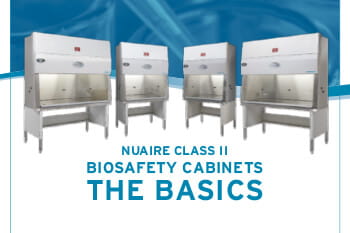
Ebook
Class II Biosafety Cabinets Guide
The ebook "NuAire Class II Biosafety Cabinets, The Basics" is an invaluable resource for anyone working with biological safety cabinets (BSCs). This guide provides a comprehensive understanding of Class II BSCs, focusing on their design, functionality, and importance in maintaining a safe laboratory environment.
Understanding Biological Safety Cabinets
Biological safety cabinets protect laboratory personnel, products, and the environment from biohazards and cross-contamination during microbiological processes. The ebook explains the principles of Class II BSCs, emphasizing the role of HEPA filtration and laminar airflow in maintaining a sterile work area.
Design and Construction
The ebook explores the meticulous design and robust construction of NuAire's Class II BSCs. It highlights features such as the monolithic shell for enhanced durability and leak minimization and ergonomic designs that reduce user fatigue. High-quality materials ensure these cabinets are reliable and long-lasting, providing consistent protection.
Functionality and Operation
The ebook details airflow dynamics in Class II BSCs, highlighting differences between various types. Type A2 cabinets recirculate 70% of air through a HEPA filter and exhaust 30%, ensuring a contamination-free environment. It also covers Type B1 and B2 cabinets with different exhaust and recirculation configurations.
Safety and Certification
Safety is paramount in laboratory environments, and the ebook outlines the rigorous testing and certification processes that NuAire BSCs undergo. These cabinets meet stringent international standards such as NSF/ANSI 49 and EN 12469, ensuring they provide the highest levels of protection. The ebook also emphasizes the importance of regular maintenance and certification to uphold these safety standards.
Applications and Versatility
NuAire's Class II BSCs are versatile tools in various laboratory settings, including clinical, pharmaceutical, and research labs. The ebook provides examples of different applications, from handling pathogens to performing sterile drug preparations, highlighting the adaptability of these cabinets to various tasks.
Maintenance and Best Practices
The ebook offers practical advice on maintaining BSCs, highlighting best practices for longevity and optimal performance. It includes guidelines on cleaning, routine checks, and the importance of using certified technicians for repairs and recertifications. These practices help maintain cabinet integrity and ensure continuous protection.
Ergonomics and User Comfort
Recognizing the importance of user comfort, the ebook discusses the ergonomic features of NuAire's Class II BSCs. Adjustable stands, contoured edges, and strategically placed armrests minimize strain and improve the working experience. Proper ergonomic design enhances comfort, increases productivity, and reduces the risk of repetitive strain injuries.
Download Your Copy
Whether you are a laboratory manager, safety officer, or technician, "NuAire Class II Biosafety Cabinets, The Basics" is a valuable resource that provides in-depth knowledge about Class II BSCs. Download the ebook today to stay informed about best practices, safety standards, and operational guidelines for using these critical laboratory tools.
This ebook will empower you with the knowledge to maintain a safe and efficient laboratory environment, ensuring both personnel and product protection from biohazards.
